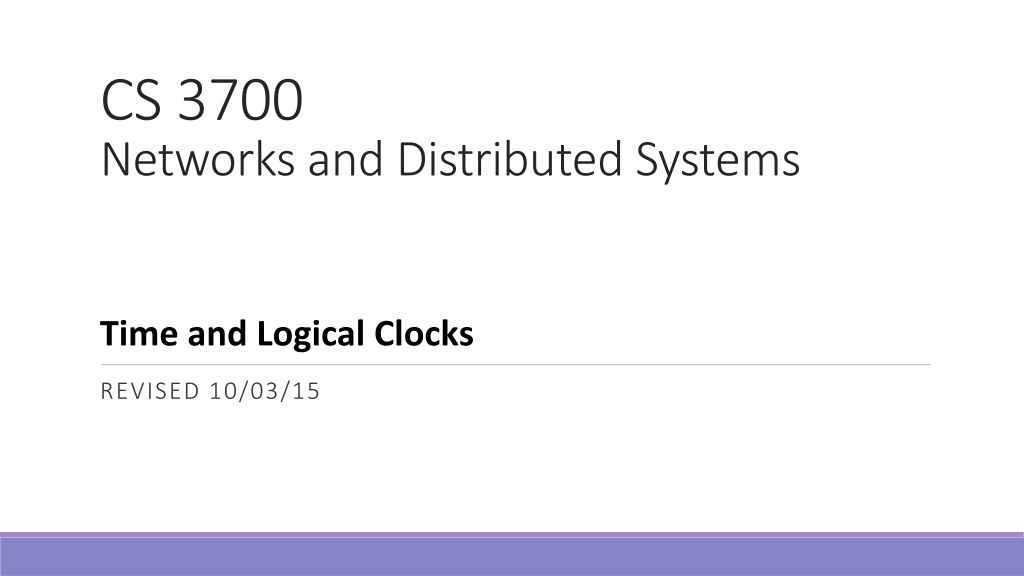Understanding Time and Clocks in Networks and Distributed Systems
Exploring the concept of time in a distributed system, this material delves into global time, practical implications, historical clocks, real-world time measurement, and GMT, UT1, and UTC. It discusses how relativity affects time perception and its importance in system design, covering topics such as logical clocks and correcting time discrepancies. The content emphasizes the need for precise timekeeping in various applications, from high-frequency trading to online gaming.
Download Presentation

Please find below an Image/Link to download the presentation.
The content on the website is provided AS IS for your information and personal use only. It may not be sold, licensed, or shared on other websites without obtaining consent from the author. Download presentation by click this link. If you encounter any issues during the download, it is possible that the publisher has removed the file from their server.
E N D
Presentation Transcript
CS 3700 Networks and Distributed Systems Time and Logical Clocks REVISED 10/03/15
Global Time In practice, we act like there is a global notion of time But, time is relative Einstein showed speed of light constant for all observers Leads to Relativity of Simultaneity Basically, impossible to tell if two events are simultaneous If events are separated by space But, if events are causally connected, we can preserve ordering 2
Global Time in Systems For human-scale systems, these time differences don t matter Rarely are we going near the speed of light But these do come to play in computing systems Must consider relativity of time when designing systems Examples: High-frequency trading systems Who bought/sold first? Merging multiple writes to single object Online games Who shot first? Did you heal before or after the attack? 3
Outline DEFINING AND MEASURING TIME CORRECTING CLOCKS AND NTP LOGICAL CLOCKS VECTOR CLOCKS 4
Historical Clocks Our units of time date from the Sumerians in 2000BC Humans used a variety of devices to measure time Sundials Astronomical clocks Candle clocks Hourglasses Mechanical clocks developed in medieval ages Typically maintained by monks (church bell tower) 5
Measuring Real-world Time Originally, each town defined noon locally Point at which sun highest in the sky With growth of railroads, this became impractical Continually have to re-set watches Hard to set rail schedules Notion of time zones developed Regions where wall-clock time is the same Now, need to synchronize clocks 6
GMT, UT1, and UTC GMT: Greenwich Mean Time Originally, mean solar time at 0 longitude This isn t really noon due to Earth s axial tilt UT1: Universal Time Modernized version of GMT Based on rotation of Earth, ~86,400 seconds/day UTC: Universal Coordinated Time UT1 + leap seconds Minutes can have 59-61 seconds Since 1972, 25 leap seconds have been introduced 7
Electrical Clocks First developed in 1920s Uses carefully shaped quartz crystal Pass current, counts oscillations Most oscillate at 32,768/sec Easy to count in hardware Small enough to fit (~4mm) Typical quartz clock quite accurate Within 15 sec/30 days (6e-6) Can achieve 1e-7 accuracy in controlled conditions Not good enough for today s applications 8
Atomic Clocks Based on atomic physics Cool atoms to near absolute zero Bombard them with microwaves Count transitions between energy levels Most accurate timekeeping devices today Accurate to within 10-9 seconds per day E.g., loses 1 second in 30 million years SI second now defined in terms of atomic oscillations 9,192,631,770 transitions of cesium-133 atom 9
International Atomic Time Atomic clocks used to define a number of time standards TAI: International Atomic Time Avg. of 200 atomic clocks, corrected for time dilation Essentially, a count of the number of seconds passed Count was 0 on Jan. 1, 1958 10
Outline DEFINING AND MEASURING TIME CORRECTING CLOCKS AND NTP LOGICAL CLOCKS VECTOR CLOCKS 11
Correctness What does it mean for a clock to be correct? Relative to an ideal clock Clock skew is magnitude, clock drift is difference in rates Say clock is correct within p if (1-p)(t -t) H(t ) - H(t) (1+p)(t -t) (t -t) True length of interval H(t ) - H(t) Measured length of interval (1-p)(t -t) Smallest acceptable measurement (1+p)(t -t) Largest acceptable measurement Monotonic property: t < t H(t) < H(t ) 12
Monotonicity If a clock is running slow relative to real time Can simply re-set the clock to real time Doesn t break monotonicity But, if a clock is running fast , what to do? Re-setting the clock back breaks monotonicity Imagine programming with the same time occurring twice Instead, slow down clock Maintains monotonicity 13
Simple Synchronization If we know message delay T A sends current time t to B, who sets time to t+T Typically, don t know exact delay May know range on delay min < T < max B can then set time to t+(max-min)/2 Clocks are then within (max-min)/2 of each other Can generalize this protocol to many clocks Overall accuracy still ~(max-min) But, don t generally have any bound on delay 14
Cristians Method No assumption of delay bound A B A sends request to B of current time B responds with local time T A measures RTT A sets local time to T+RTT/2 RTT Sample Assumes that delay is symmetric Why? A can do this many times in a row, use overall min RTT Rough accuracy is RTT/2 - min, with overall minimum min 15
Synchronization in the Real-world Network Time Protocol (NTP) developed in 80s with goals Keep machines synchronized to UTC Deal with lengthy losses of connectivity Enable clients to synchronized frequently (scalable) Avoid security attacks NTP deployed widely today Uses 64-bit value, epoch is 1/1/1900 (rollover in 2036) LANs: Precision to 1ms Internet: Precision to 10s of ms 16
NTP Hierarchy Based on hierarchy of accuracy, called strata Stratum 0: High-precision atomic clocks Stratum 1: Hosts directly connected to atomic clocks Stratum 2: Hosts that run NTP with stratum 1 hosts Stratum 3: Hosts that run NTP with stratum 2 hosts Stratum x hosts often synch with other stratum x hosts Provides redundancy 17
NTP in Practice Run on UDP port 123 Most Internet hosts support NTP Accuracy on general Internet is ~10ms Up to 1ms on local networks, ideal conditions Many networks run local NTP servers E.g., time.ccs.neu.edu NTP has recently been a vector for DDoS attacks Best practice is for servers to filter requests outside local network 18
Outline DEFINING AND MEASURING TIME CORRECTING CLOCKS AND NTP LOGICAL CLOCKS VECTOR CLOCKS 19
Logical Ordering Problem: even with NTP, time synchronization is still approximate In a cluster of machines, clocks may be skewed by 1ms or more Some applications cannot tolerate such high skew Goal: Be able to provide some synchronization of events Create a new abstraction: Logical ordering Remove real-world time from equation Base ordering on causality Logical clocks are based on the simple principles: 1. Events observed by a single process are ordered 2. Any message must be sent before it is received 20
Example of Logical Ordering A m1 m2 B m3 C m4 m5 D Each host can order all events it observes B observes m1 received before m3 sent Can interleave timelines via messages Cannot make statement about all pairs of events E.g., m5 send and m1 receive can t be ordered 21
Happened-before Relation A m1 m2 B m3 C m4 m5 D Formalize logical clocks via happened-before ( ) relation If e1 precedes e2 on single host, then e1 e2 e1 e2 and e2 e3, then e1 e3 (transitivity) If neither e1 e2 nor e2 e1, then e1 and e2 are concurrent Say e1 || e2 22
Limits of Happened-before Cannot capture external events Only considers message-passing Two events may be concurrent in our system If e1 || e2, it does not imply causality Potential causality is implied E.g., process may receive message before unrelated event But, still pretty useful How to implement logical ordering in a real system? 23
Logical Clocks Turing Award winner Leslie Lamport invented a way to create logical clock from ordering Define logical clock to be a monotonically increasing value Number is abstract, meaningless value by itself Each host i maintains internal logical clock Li Li is incremented after each event Li logical timestamp is included in each message sent Upon receipt of message with logical timestamp t Li = max(Li, t) + 1 24
No Reverse Implication 1 0 2 A a b c 0 4 B 3 d f 1 e 0 C 5 We can observe that e1 e2 L(e1) < L(e2) If e1 happened before e2, then logical clocks ordered But the reverse is not true L(e1) < L(e2) e1 e2 For example, L(e) < L(b), but e b In fact, e concurrent with all but f 25
Outline DEFINING AND MEASURING TIME CORRECTING CLOCKS AND NTP LOGICAL CLOCKS VECTOR CLOCKS 26
Vector Clocks Developed to overcome lack of reverse implication Want L(e1) < L(e2) e1 e2 Processes keep local vector clock Vi Array of logical clocks of length N (# processes) Initially [0,0, 0] Similar update procedure to logical clocks Vi[i] is incremented after each event Viis inserted into each message sent Upon receipt of message with vector clock Vk Vi[x] = max(Vi[x], Vk[x]), for all x 27
Vector Clock Example [2,3,0,0] ? [3,3,4,0] ? [1,0,0,0] A m1 m2 [1,2,0,0] B Vector Key: [LA, LB, LC, LD] [1,3,0,0] [1,1,0,0] m6 m3 [0,0,1,0] [0,0,2,0] C [1,2,4,0] ? [1,2,3,0] m4 m5 D [0,0,2,2] [0,0,1,1] Invariant: Vi[b] is the number of events in process Pb that happened before the current state of process Pa 28
Comparing Vector Timestamps Given two vector timestamps Vi and Vj Vi = Vjiff Vi[x] = Vj[x] for all x Vi < Vjiff Vi[x] < Vj[x] for all x For example: (2,4,1) < (3,5,9) But, other pairs incomparable E.g., (2,4,1) and (3,1,7) As with logical clocks e1 e2 L(e1) < L(e2) And also L(e1) < L(e2) e1 e2 29
Vector vs. Logical Clocks Vector clocks augment logical clocks Use generalization of same mechanism Both can say when certain events happened before each other But, only vector clocks allow you to compare events across processes Challenges with vector clocks Larger messages, more complexity Often don t know total number of processes (N) N may change while your system is executing Vector clocks can be extended to matrix clocks Your logical clock + others 30
The Future? Spanner: Google s Globally-Distributed Database Corbett et al., OSDI 2012 https://research.google.com/archive/spanner-osdi2012.pdf Highly available, highly consistent, load balanced database Special time master servers equipped with GPS antenna and atomic clocks Apparently atomic clocks aren t too expensive (for Google) Cluster machines synchronize with the masters every 30 seconds 31























